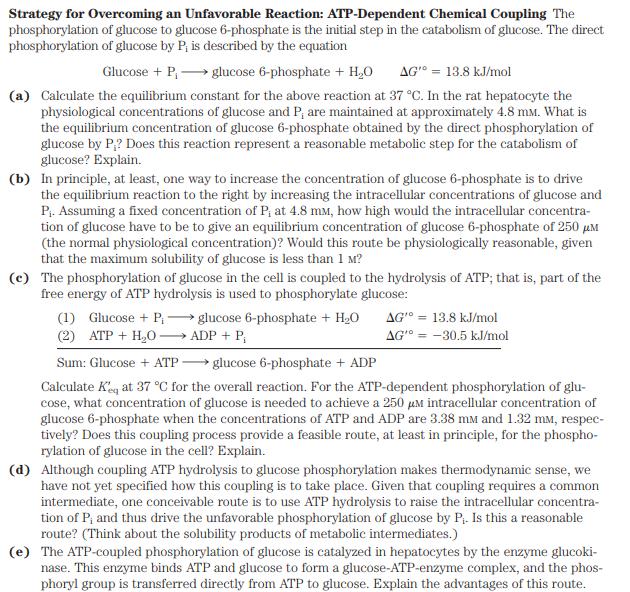Answered step by step
Verified Expert Solution
Question
1 Approved Answer
Strategy for Overcoming an Unfavorable Reaction: ATP-Dependent Chemical Coupling The phosphorylation of glucose to glucose 6-phosphate is the initial step in the catabolism of

Strategy for Overcoming an Unfavorable Reaction: ATP-Dependent Chemical Coupling The phosphorylation of glucose to glucose 6-phosphate is the initial step in the catabolism of glucose. The direct phosphorylation of glucose by P, is described by the equation Glucose + Pglucose 6-phosphate + HO AG" = 13.8 kJ/mol (a) Calculate the equilibrium constant for the above reaction at 37 C. In the rat hepatocyte the physiological concentrations of glucose and P, are maintained at approximately 4.8 mm. What is the equilibrium concentration of glucose 6-phosphate obtained by the direct phosphorylation of glucose by P? Does this reaction represent a reasonable metabolic step for the catabolism of glucose? Explain. (b) In principle, at least, one way to increase the concentration of glucose 6-phosphate is to drive the equilibrium reaction to the right by increasing the intracellular concentrations of glucose and P. Assuming a fixed concentration of P, at 4.8 mm, how high would the intracellular concentra- tion of glucose have to be to give an equilibrium concentration of glucose 6-phosphate of 250 M (the normal physiological concentration)? Would this route be physiologically reasonable, given that the maximum solubility of glucose is less than 1 M? (e) The phosphorylation of glucose in the cell is coupled to the hydrolysis of ATP; that is, part of the free energy of ATP hydrolysis is used to phosphorylate glucose: (1) Glucose + P (2) ATP + H0 ADP + P glucose 6-phosphate + HO AG' = 13.8 kJ/mol AG' -30.5 kJ/mol Sum: Glucose + ATP glucose 6-phosphate + ADP Calculate Keq at 37 C for the overall reaction. For the ATP-dependent phosphorylation of glu- cose, what concentration of glucose is needed to achieve a 250 M intracellular concentration of glucose 6-phosphate when the concentrations of ATP and ADP are 3.38 mM and 1.32 mm, respec- tively? Does this coupling process provide a feasible route, at least in principle, for the phospho- rylation of glucose in the cell? Explain. (d) Although coupling ATP hydrolysis to glucose phosphorylation makes thermodynamic sense, we have not yet specified how this coupling is to take place. Given that coupling requires a common intermediate, one conceivable route is to use ATP hydrolysis to raise the intracellular concentra- tion of P, and thus drive the unfavorable phosphorylation of glucose by P. Is this a reasonable route? (Think about the solubility products of metabolic intermediates.) (e) The ATP-coupled phosphorylation of glucose is catalyzed in hepatocytes by the enzyme glucoki- nase. This enzyme binds ATP and glucose to form a glucose-ATP-enzyme complex, and the phos- phoryl group is transferred directly from ATP to glucose. Explain the advantages of this route.
Step by Step Solution
There are 3 Steps involved in it
Step: 1
The detailed ...
Get Instant Access to Expert-Tailored Solutions
See step-by-step solutions with expert insights and AI powered tools for academic success
Step: 2

Step: 3

Ace Your Homework with AI
Get the answers you need in no time with our AI-driven, step-by-step assistance
Get Started


